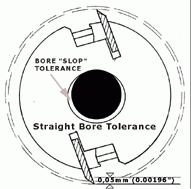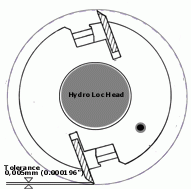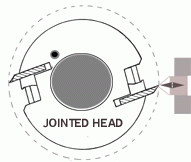This article was reprinted with permission from Wood Tech Tooling, www.woodtechtooling.com.
Cutterhead Selection
The options for cutterhead selection are mind-boggling. Below are some general guidelines to narrow down your choices.
Many factors determine proper cutterhead selection. One of the most important factors is feed rate. Most small shops use a feed rate of 50 Feet Per Minute( FPM) or less and have, as a result, a single-knife finish. For this application, a Straight Bore cutterhead is most commonly used. Accuracy is limited due to the "slop" necessary to physically fit the cutterhead onto the spindle shaft. The bore on the head is normally .001" to .002" oversized to accomplish an easier fit. The end result is that one knife in the head will be higher in the cutting circle, thus producing a single-knife finish.

Many older "push-feed" machines, with feed rates from 35 to 250 FPM), use Self-Centering Sleeve (SCS) heads. This head incorporates a removable sleeve that locks the head onto the spindle. Accuracy is again affected due to both the "slop" tolerance from the head to the sleeve, and also the "slop" from the sleeve to the shaft. This can result in tolerances of several thousandths of an inch. The condition of the head, and the machine's spindle, is critical to produce quality material out of the moulder. These heads can be jointed, but extreme care must be taken not to over joint the knives.
Hydro Lock head use is normally reserved to companies with high speed machines with the tightest of machine tolerances. In house grinding capabilities are a must to get the full benefit from the tooling. Hydro Lock heads use a pressurized sleeve to create a much tighter fit on both the grinder and the moulder.

The further use of the jointing process produces a cutter capable of increased feed rates because all knives are in the same cutting circle. This process uses an abrasive stone that strikes the knives while the head is rotating. Jointing actually "dulls" the knives, so care must be taken not to over joint the knives.
Spindle Type and Condition
Machines with standard bearings would normally use Straight Bore or SCS type heads. Machines with high precision (normally angular contact thrust) bearings (including outboard bearings) better justify the use of Hydro Lock heads. The condition of the spindle greatly affects the material produced. A spindle that has had a head "spun" on it, been de-burred or sanded may be undersized (over .005") for standard Hydro Lock heads to grip safely. A cutterhead could possibly distort due to the "memory" of the steel sleeve. Newer "hardened" sleeves are designed to successfully span a larger gap, or even keyways, without distorting.
The use of a Safety Locking Collar is highly recommended to reduce possible head, or spindle, damage resulting from a Hydro Head spinning on the shaft.

Machine Condition
A tool is only as good as the machine it's run on and the operator that runs it. Both the grinder and the moulder must be kept in top condition to produce an acceptable product. The moulder must be properly set up and aligned. This includes checking fences, tables, feed rollers for both alignment and wear. The vast majority of "tooling problems" are actually the result of a machine problem. A smaller percentage is the result of improperly specified tooling for the application.
Only 5% of "tooling problems" are truly related to tooling. Proper operator knowledge and training is a very important factor more commonly overlooked than you might think. An operator that understands the nature of the tooling and machinery being used is better equipped to produce quality products.
This article was reprinted with permission from Wood Tech Tooling, www.woodtechtooling.com.